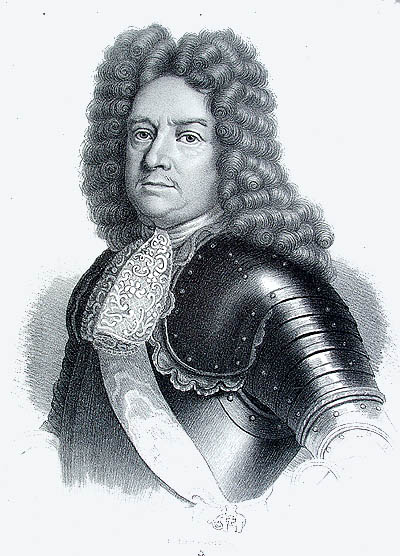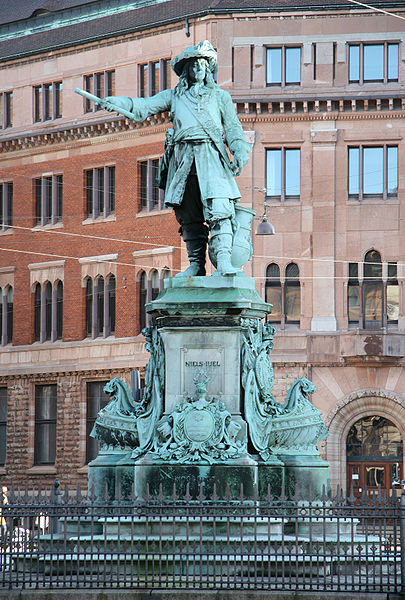<Back to Index>
- Jurist Andrea Alciato, 1492
- Film Director Roberto Rossellini, 1906
- Admiral Niels Juel, 1629
PAGE SPONSOR


Niels Juel (8 May 1629 – 8 April 1697) was a Dano - Norwegian admiral.
Brother of diplomat Jens Juel and oldest son of Erik Juel and Sophie Clausdatter Sehested, both were descendant of Danish nobility. He was born at Christiania in Norway, though his family came from Jutland. His mother was temporarily staying in Norway during the invasion of the Danish peninsula in 1627 - 1628 by the army of Albrecht von Wallenstein in the Thirty Years' War. From the age of 6 he was brought up by his aunt Karen Sehested at Stenalt in Denmark. He served his naval apprenticeship under Maarten Tromp and Michiel de Ruyter, taking part in all the chief engagements of the First Anglo-Dutch War (1652 – 54) between England and the Netherlands. During a long indisposition at Amsterdam in 1655 - 1656 he acquired a thorough knowledge of shipbuilding, and returned to Denmark in 1656 a thoroughly equipped seaman. He served with distinction during the Dano-Swedish Wars of 1658 - 60 and took a prominent part in the defence of Copenhagen against Charles X of Sweden.
During fifteen years of peace, Juel, as admiral of the fleet, labored assiduously to develop and improve the Royal Dano-Norwegian Navy, though he bitterly resented the setting over his head in 1663 of Cort Adeler on his return from the Turkish wars. In 1661 Juel married Margrethe Ulfeldt. On the outbreak of the Scanian War he served at first under Adeler, but on the death of the latter in November 1675 he was appointed to the supreme command.
He then won a European reputation, and raised Danish sea power to unprecedented eminence, by the system of naval tactics, perfected by Michiel de Ruyter in the Third Anglo-Dutch War and afterwards by Horatio Nelson, which consists in cutting off a part of the enemy's force and concentrating the whole attack on it. He first employed this manoeuvre at the Battle of Jasmund off Rügen (25 May 1676) when he broke through the enemy's line in close column and cut off five of their ships, which, however, nightfall prevented him from pursuing. Juel's operations were considerably hampered at this period by the conduct of his Dutch auxiliary, Philips van Almonde, who accused the Danish admiral of cowardice. A few days after the battle of Jasmund, Cornelis Tromp son of Maarten with 17 fresh Danish and Dutch ships of the line, superseded Juel in the supreme command.
Juel took a leading part in Cornelis Tromp's great victory off Battle of Öland (1 June 1676), which enabled the Danes to invade Scania unopposed.
On the 1st of June 1677 Juel defeated the Swedish admiral Erik Carlsson Sjöblad in the Battle of Møn. On the 30th of June 1677 he won his greatest victory, in the Battle of Køge Bay (though it really happened at Stevns, seeing that the ships never entered the bay), where, with 25 ships of the line and 1267 guns, he routed the Swedish admiral Henrik Horn with 36 ships of the line and 1800 guns. For this great triumph, the just reward of superior seamanship and strategy at an early stage of the engagement, Juel's experienced eye told him that the wind in the course of the day would shift from S.W. to W. and he took extraordinary risks accordingly; he was made lieutenant admiral general and a privy councillor. This victory, besides permanently crippling the Swedish navy, gave the Danes the self-confidence to become less dependent on their Dutch allies.
In the following year Cornelis Tromp was discharged by Christian V, who gave the supreme command to Juel. In the spring of 1678 Juel put to sea with 84 ships carrying 2,400 cannon, but as the Swedes were no longer strong enough to encounter such a formidable armament on the open sea, his operations were limited to blockading the Swedish ports and transporting troops to Rügen.
After the Treaty of Lund, Juel showed himself an administrator and reformer of the first order, and under his energetic supervision the Danish navy ultimately reached imposing dimensions, especially after Juel became chief of the admiralty in 1683. Personally Juel was the noblest and most amiable of men, equally beloved and respected by his sailors, simple, straightforward and unpretentious in all his ways. During his latter years he was popularly known in Copenhagen as the "good old knight". He is buried in the Church of Holmen.